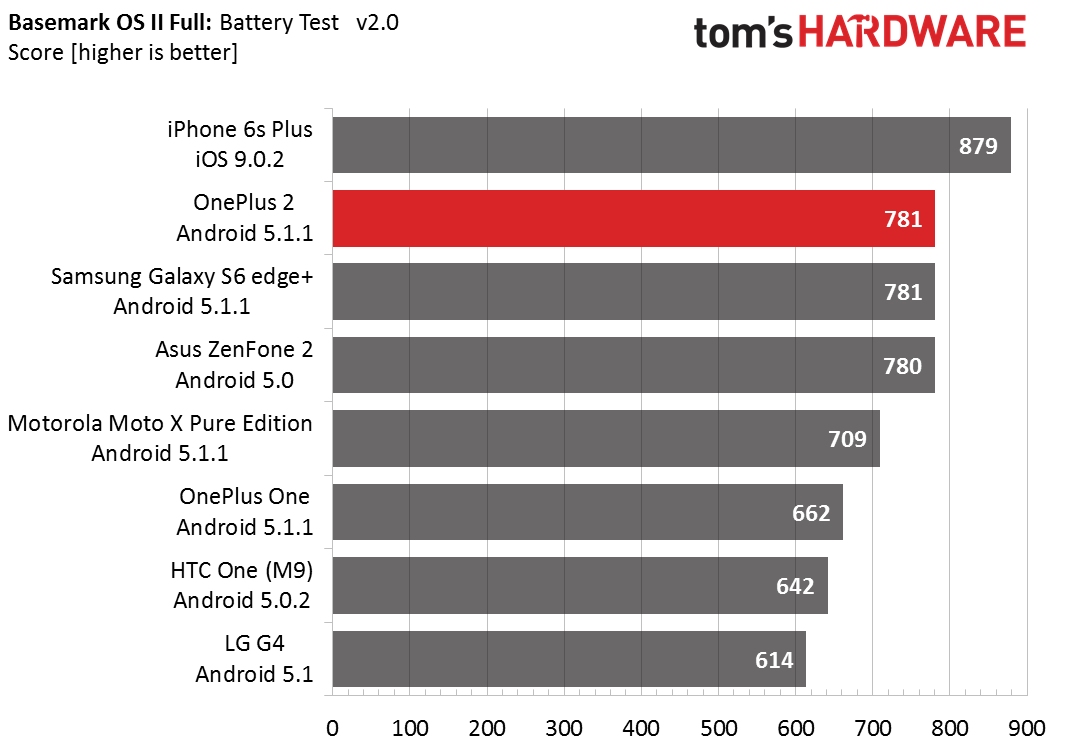OnePlus 2 Review
OnePlus proudly boasts that its latest smartphone is a "flagship killer." Does the OnePlus 2 have the arsenal to slay its competitors or is its metal chassis just filled with hot air?
Why you can trust Tom's Hardware
Battery Life And Thermal Throttling
Battery life may be the most important performance metric for a mobile device. After all, it does not matter how quickly a phone or tablet can load webpages or how many frames per second the GPU can crank through once the battery runs down and the device shuts off. To learn more about how we test this critical facet of mobile computing, please read our battery testing methodology article.

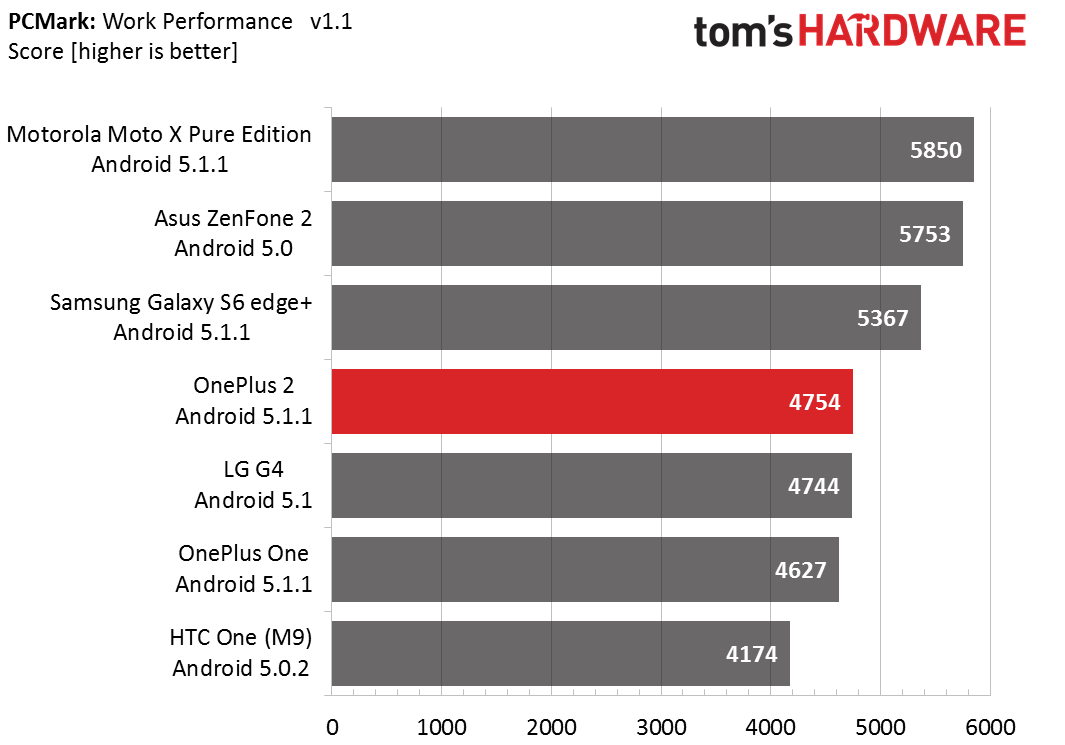
The OnePlus 2’s more conservative use of its A57 CPU cluster limits performance, but it definitely helps improve battery life in PCMark, which estimates battery life using real-world workloads and reflects how long a phone can last while continuously working on common tasks. It lasts about a half hour longer than the OnePlus One, while offering similar overall performance, and over two hours longer than the HTC One M9 and its smaller battery. The Galaxy S6 edge+, despite having a smaller battery and delivering better performance by using its A57 CPU cores more heavily, still lasts a half hour longer than the OnePlus 2.
Battery life, however, is only part of the story; we also have to take performance into account. By multiplying the PCMark battery life by the overall performance score and dividing by 1000, we get a composite metric that gives us an estimate for how much total work can be done on a single charge.
| PCMark Composite Work Score | ||||||
|---|---|---|---|---|---|---|
| Galaxy S6 edge+ | OnePlus 2 | Moto X Pure Edition | ZenFone 2 | OnePlus One | LG G4 | HTC One M9 |
| 2807 | 2139 | 2100 | 2100 | 1948 | 1656 | 1306 |
The OnePlus 2 fares well in this comparison, allowing you to get more total work done on a single charge. The S6 edge+ still comes out ahead, though, thanks to its Exynos 7420 SoC that’s manufactured on Samsung’s more power efficient 14nm FinFET node.
Basemark OS II runs CPU-intensive, multi-threaded workloads, and its overall score accounts for both battery life and performance. This is really a worst case scenario for CPU power consumption, since running your phone’s CPU full tilt for several hours is highly unrealistic. It does push the phones hard enough to trigger thermal throttling, which is why we see the results clump together in a less than intuitive manner. In the case of the OnePlus 2, it starts throttling its A57 cores (running two at a time) very quickly after starting the test. After 19 minutes, it shuts the A57 cluster off completely, running almost the whole test on just the A53 cluster. Starting the test after doing some web browsing and other light UI tasks to get the phone warm but not hot causes the OnePlus 2 to shut down the A57 cluster after only two minutes. This shows that the Snapdragon 810's A57 cores are truly limited to short duration, bursty workloads.
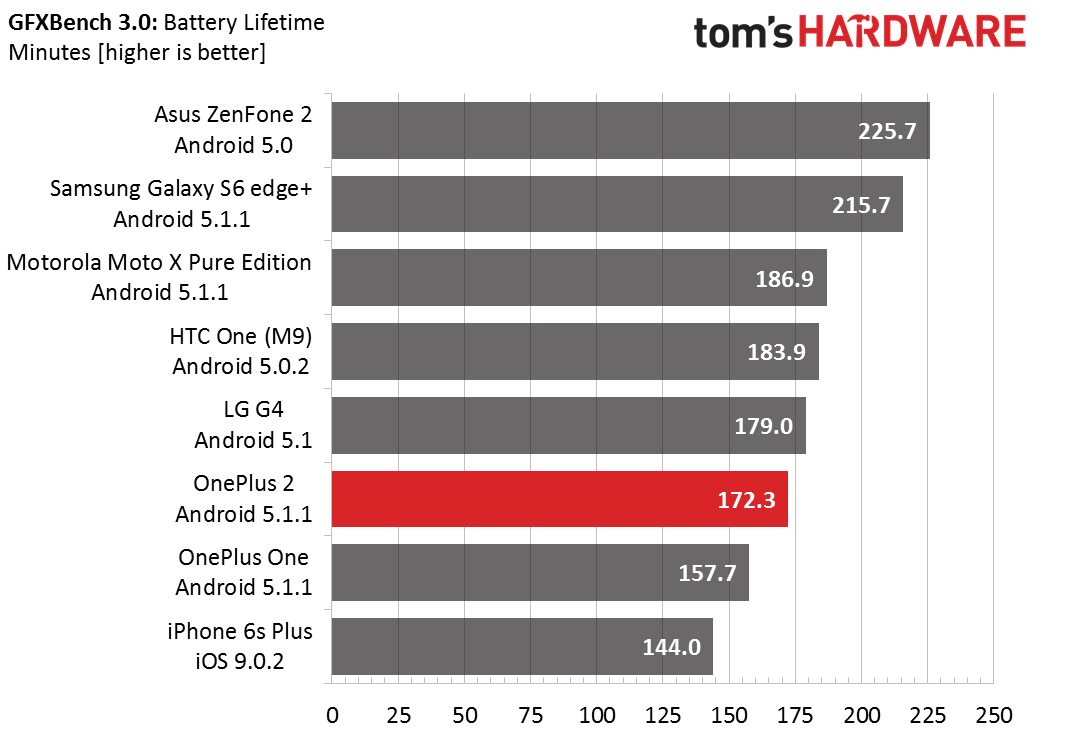
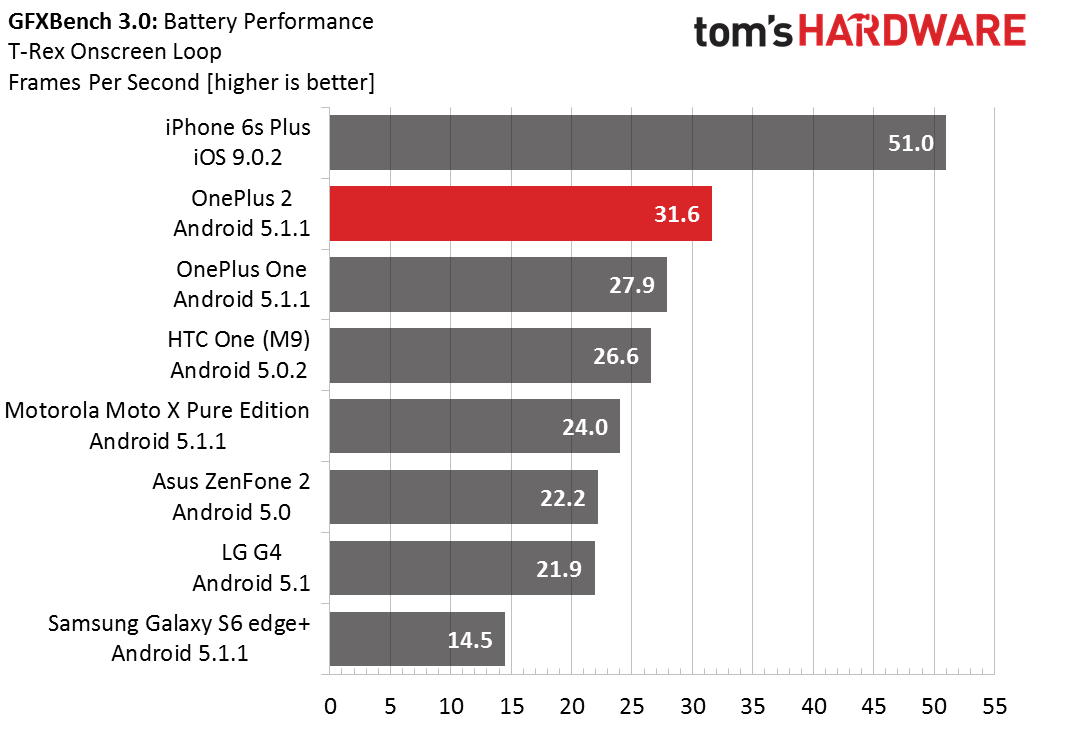
The GFXBench 3.0 battery test focuses on the GPU and is an indicator of battery life during intense gaming. It also effectively gauges a device’s ability to dissipate heat.
Most of the phones in the chart last right around three hours, and the OnePlus 2 is no different. It manages to last about 15 minutes longer than the OnePlus One at a slightly higher performance level. All of the phones in the chart experience some thermal throttling except the OnePlus One, Moto X Pure Edition, and iPhone 6s Plus (negligible). This is one reason why phones like the One M9 and Galaxy S6 edge+ last longer than the OnePlus 2—they run their GPU at a lower clock speed, which consumes less power.
Get Tom's Hardware's best news and in-depth reviews, straight to your inbox.
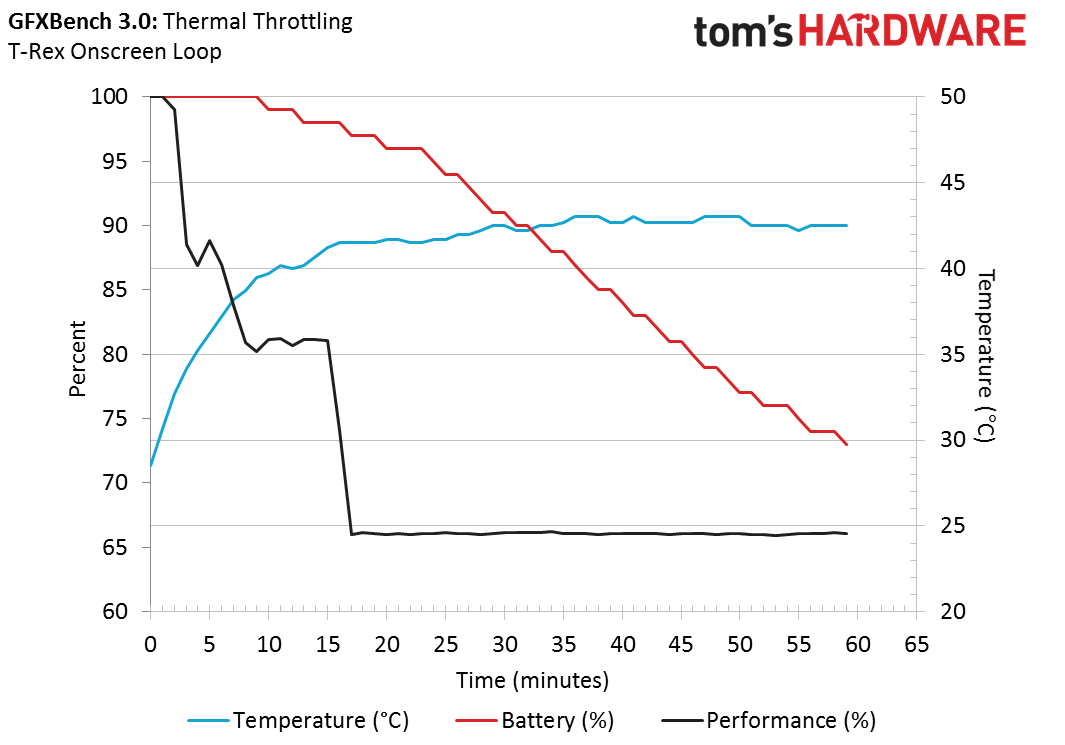
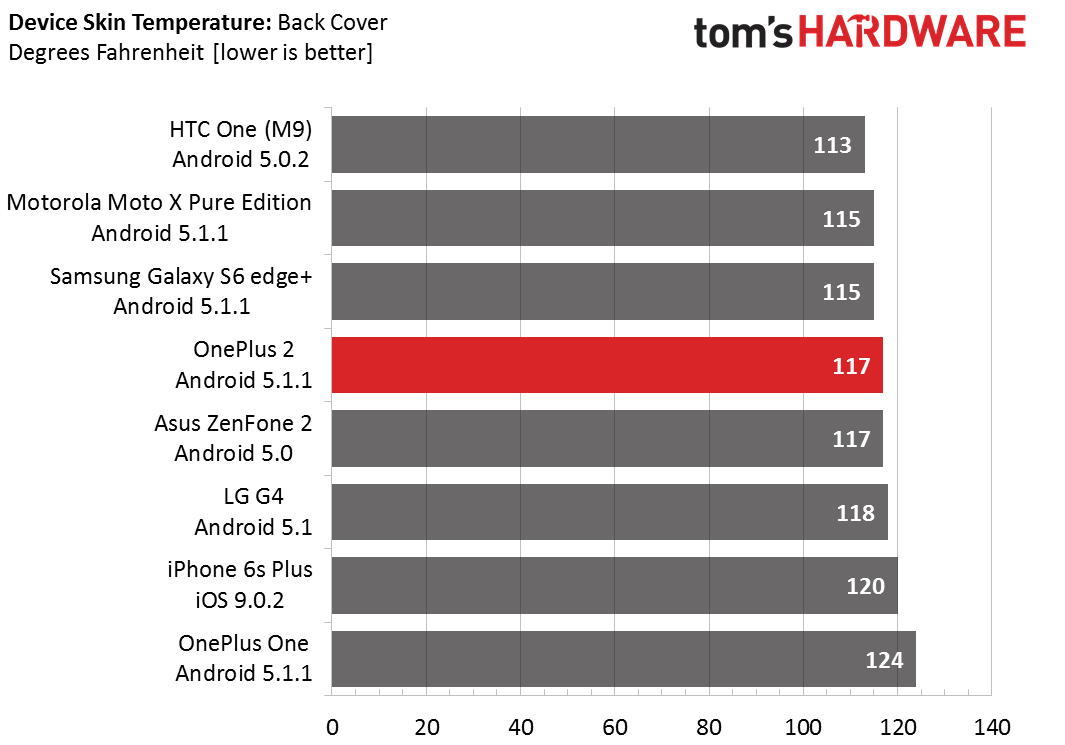
The OnePlus 2 throttles less than the One M9, and its Adreno 430 GPU runs more efficiently than the Mali-T760MP8 GPU in the Galaxy S6 edge+, which throttles quite heavily, but it still experiences some thermal throttling as seen in the chart above. After about four minutes, the OnePlus 2 sheds 15 percent of its peak performance, and by the seven-minute mark throttling has reduced performance by 20 percent. Performance stabilizes at 66 percent of peak level after 17 minutes, which is still faster than the Adreno 330 in the OnePlus One running at 100 percent. The skin temperature on the back of the phone remains below 120 °F, which is the generally accepted limit where the device becomes uncomfortable to hold.
Current page: Battery Life And Thermal Throttling
Prev Page GPU And Gaming Performance Next Page Conclusion-
ChuckUfarleys How much did Oneplus pay you for this inane review that is for a phone that is 6 months old?Reply
You reviewers NEVER bring up the terrible customer service, the terrible buggy Oxygen O.S., the constant everyday posts about how bad the Two is in their own forum.
Why would you even use the One for comparison, it's a TWO year old phone!
Why is that, are you too afraid to NOT recommend this phone? -
juanjovargas @ChuckUfarleys then a half-price and 6-months-old phone is comparable in terms of performance to the best phones of every brand? YESReply -
ctmk I rather get a redmi note.Reply
https://www.youtube.com/watch?v=gGLW-kzh6sI
the CPU is only effectively quad core 1.55ghz and will throttle to 800mhz in just few min of video soft decoding stress test. -
ubercake Looks like the new ZenPhone with its 3x optical zoom on the rear-facing camera may also be a looker in this price range.Reply -
Abdurrasheed Desai Lol the OP2s price just went down. It is more worth it now than it ever was.Reply -
mellis I still like my OnePlusOne. It also works great with Straigthtalk. No contract and no bloatware is the way to go! No way am I going to over $400 for a phone.Reply -
Spinachy Operating Systems all have security problems that need to be patched regularly. This is an important buying consideration for me. You do not mention on what schedule OnePlus will be patching the OS?Reply -
zvancu I own a OnePlus 2 and I have to say that I would wish that at least one of the reviews I see online would mention how terrible their customer support is. It seems that it's pretty common knowledge, but I never saw this before actually buying the phone.Reply
I have to say that at first I was happy with the device, but now I am having some issues with it and I contacted the support. At first they were stalling with some meaningless questions (like what's my IMEI even I had already provided it) but now I got to the point where they are simply ignoring me. It has been more then a week in which I wrote 5 messages and they did not even acknowledge that they saw them, not to mention actually doing something. -
jacobian The bottom line it seems, there is no need to upgrade if you already own a Oneplus One. I have one Oneplus One (64GB) in the family running the stock CyanogenOS, and I see no reason to upgrade it. Very good smartphone all around. Hope the next generation will be better.Reply
